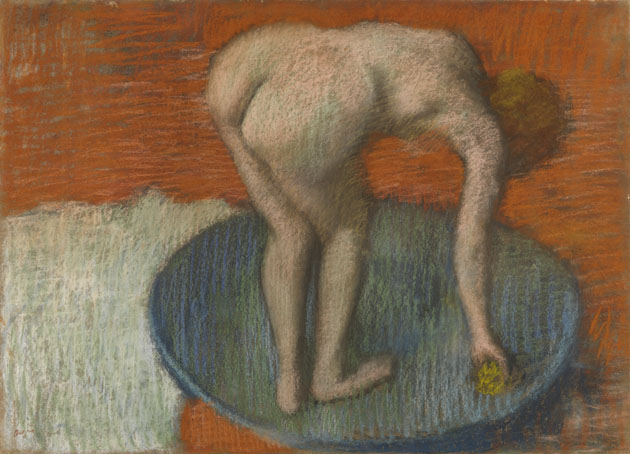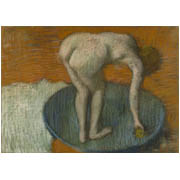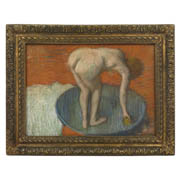Details
- Object type
pastel
- Title
Woman in A Tub
- Artist/Maker
- Culture/School
French
- Place Associated
Paris, France (place made)
- Date
circa 1896-1901
- Materials
pastel on cream-coloured wove paper
- Dimensions
framed: 830 mm x 1060 mm x 80 mm; unframed: 608 mm x 846 mm
- Description
-
In this striking pastel Degas depicts a nude woman, seen from behind and close to, bending to the right, about to bathe with the sponge she holds in her right hand. She is standing in a shallow metal tub whose predominant tones of blue complement the vibrant orange background of the surrounding space.
Some fifteen years earlier Degas had already been acknowledged, in avant-garde Parisian circles, as the leading artist of the nude. The female nude was the central subject in his art. Approximately one fifth of Degas’s output - in paintings, pastels, drawings, prints and sculpture – was of the nude. It dominated the last twenty years of his career.
This rather awkward, angular nude is based on one of several works depicting a bather in a shallow tub that Degas executed in the mid-1880s. It is closest to Woman bathing in a shallow tub (Hiroshima Museum of Art). The pose in both works is similar but the Hiroshima pastel – which was probably begun in the mid 1880s and then reworked in the 1890s – shows that we are in the woman’s bedroom and gives more precise details of the fabric of the carpet and curtains.
Although Degas re-uses an earlier pose how would he have worked on the pastel? Would he have referred back to the earlier works, would he have worked from memory or would he have used a model to pose for him? It is difficult to know for certain. Although late in life Degas was fond of asserting that a good artist should be capable of working from memory, there is plenty of evidence – from his friends and his models – to show that Degas worked from life right up until the end of his career.
From the early 1880s the medium Degas preferred to work in was pastel. This was a natural choice for a skilled draughtsman because it allowed him to draw with colour using varied and gestural strokes. Degas seems to have enjoyed the breadth and amplitude of line that pastel allowed him and also the jagged, raw quality of each stroke. In addition, pastel allowed Degas, the perfectionist, to change his mind.
Unlike oil, which needs scraping down if a mistake is made – and which eventually takes on a muddy appearance if too many such changes are made - pastel allows the artist to work over the surface in a series of layers, making alterations as necessary. It is also possible that Degas preferred to use pastel because of his deteriorating eyesight. He suffered from myopia, an irregular field of vision and an intolerance of bright light.
If in the 1880s Degas’s pastels remained essentially faithful to local colour, by the following decade, as can be seen here, he was increasingly using exaggerated - and not necessarily realistic - colour combinations. Here Degas has used strong directional strokes of bold colour – blue, green, orange, pink, white - which have been laid over heavily stumped, darker, ground colours.
Degas began by delineating the contours of the woman’s body with dark lines, and then used hatched strokes of mint green and pink to establish the flesh tone. Quick, jagged strokes of orange and yellow suggest the form of the woman’s right breast and equally hasty strokes of yellow imply the form of her right thigh. The woman’s surroundings are blocked in in confident, bold areas, forming, like her, square and rectangular forms which contrast with the shape of the oval tub.
Contemporary critics admired Degas’s nudes for their realism – for Degas’s accurate observation of the imperfections of the flesh. These critics appreciated his works because they found them truthful, unlike the ‘whitened, pinkened, soufflé-like flesh of [the] academic formula’ they so despised. The critic Geffroy, for example, insisted that Degas’s nudes represented ‘a real naked woman’ expressed with more
- Credit Line/Donor
Gifted by Sir William and Lady Burrell to the City of Glasgow, 1944
- Collection
Burrell Collection: Pictures [Oils, Pastels and Watercolours]
- ID Number
35.236
- Location
In storage



